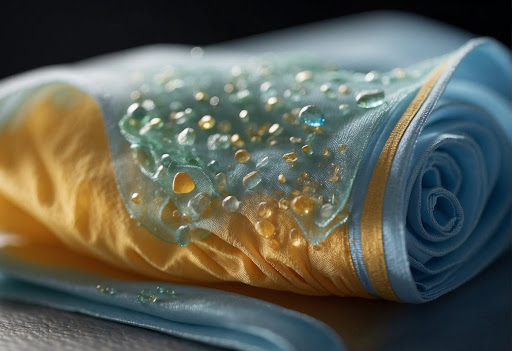When it comes to clothing materials, polyester is a popular choice known for its durability, resistance to wrinkles, and ability to retain shape. One frequently asked question is whether polyester can shrink. Unlike natural fibers like cotton or wool, which are known to shrink under certain conditions, polyester is a synthetic fabric that is less susceptible to shrinkage. However, that doesn’t mean it’s completely shrink-proof. Exposing polyester to high temperatures, whether through washing or drying, can cause the fibers to contract and thus lead to some degree of shrinkage.
Understanding the nature of polyester’s reaction to heat helps in maintaining the quality of your clothing. Polyester is a kind of plastic, and like many plastics, it has a certain temperature threshold. If you wash or dry your polyester garments at temperatures above this threshold, you may notice a change in their size and fit. Nevertheless, the material is quite resilient, and if you handle it correctly, with appropriate temperature settings, you can minimize or even avoid the risk of shrinking altogether.
Caring for your polyester items properly requires knowing the right techniques. It’s wise to adhere to care labels on your clothing, as they provide the specific instructions for temperature and washing methods suitable for the fabric. By following these guidelines, you can preserve the integrity and longevity of your polyester garments, keeping them looking their best wear after wear.
Understanding Polyester
Polyester, a prevalent synthetic fabric, offers you durability and versatility. It’s a textile that’s resistant to shrinking, which makes it a popular choice for clothing and other uses.
Characteristics of Polyester
Polyester is crafted from polyethylene terephthalate (PET) and is known for being durable and strong. It gains a hydrophobic quality from its synthetic fibers, allowing materials to resist water absorption. This attribute contributes to its moisture-wicking and quick-drying properties, making it apt for active wear. Furthermore, polyester is wrinkle-resistant and odor-resistant, ensuring that your garments maintain a crisp, fresh look with minimal maintenance.
- Durability: High resistance to stretching, shrinking, and abrasions.
- Maintenance: Machine washable and dries quickly; retains shape over time.
- Breathability: Varies; can be engineered for better air circulation.
Polyester Versus Other Fabrics
When comparing polyester to other fabrics, its synthetic nature makes it more durable and wrinkle-resistant than natural fibers like cotton or silk. In contrast to wool, polyester is not absorbent, yet it can be engineered for enhanced breathability which is a must-have feature for sportswear. It’s also comparatively more affordable and provides excellent color retention across washes.
| Feature | Polyester | Natural Fabrics |
| Shrink Resistance | Excellent | Variable |
| Durability | High | Medium to High |
| Quick-Drying | Yes | No |
| Wrinkle Resistance | High | Low to Medium |
Common Uses of Polyester in Clothing
Your wardrobe likely contains a diverse range of polyester clothing due to its versatility. Common apparel includes active wear, where the fabric’s stretchy and quick-drying qualities are crucial. Polyester is also a mainstay in outerwear, like jackets and coats, because of its ability to provide warmth without weight. Moreover, its hydrophobic nature makes it ideal for raincoats and similar weather-resistant garments.
- Active Wear: Leveraging wicking and quick-dry to keep you comfortable.
- Outerwear: Offering warmth while being lightweight and weather-resistant.
- Formal Wear: Popular in suits and dresses due to easy maintenance and sleek appearance.
The Science of Shrinkage

Understanding how and why materials like polyester resist or undergo shrinkage is crucial if you want to maintain the shape and fit of your clothing over time.
What Causes Fabrics to Shrink?
Fabrics shrink primarily due to the application of heat and moisture. When you wash or dry your clothing at high temperatures, the fibers that were stretched during the manufacturing process can contract. Natural fibers, such as wool and cotton, are particularly prone to this type of shrinkage because their fibers can easily absorb water and are sensitive to heat.
Polyester’s Resistance to Shrinkage
100% polyester is a synthetic fiber that is engineered to be resistant to shrinkage. Unlike natural fibers, polyester doesn’t absorb water easily, thus reducing the risk of shrinking. When exposed to heat, polyester fibers maintain their stability better than many natural fibers do. However, extremely high heat can still cause polyester to shrink slightly, but not to the same extent as wool or cotton.
Polyester Blend Considerations
With polyester blends, such as cotton-polyester, the risk of shrinkage increases, but is still less than that of pure natural fibers. It is often asked whether polyester shrinks more than cotton. The answer is no; polyester typically shrinks less. However, when blended, the shrink in the dryer or wash must be considered in relation to the ratio of synthetics to natural fibers. The more cotton present, the greater the potential for shrinkage.
Washing and Drying Polyester

Ensuring your polyester garments maintain their shape and size involves proper laundering techniques and drying methods. High temperatures can lead to changes in the fabric, so pay close attention to the care label.
Proper Washing Techniques
To wash your polyester garments correctly, always check the care label for specific instructions. Generally, polyester is machine-washable, but to avoid shrinking:
- Use cool to warm water settings, as boiling water or hot settings may cause shrinkage.
- Gentle cycles are preferable to protect the durability of the fabric.
- For stains, pre-treat them before washing. Avoid soaking polyester in harsh chemicals.
- Add a towel to the washing machine to minimize the friction that can contribute to wear.
Drying Polyester the Right Way
Drying polyester requires careful attention to prevent damage:
- The care label may suggest to tumble dry on low or air-dry, as high temperatures can shrink polyester.
- If you’re using a dryer, remove the garment while it’s still slightly moist to iron easily if needed.
- Air-drying is safe and can be done by laying the garment flat on a towel to help absorb any excess moisture.
By adhering to these instructions, you can reduce the chances of shrinkage and maintain the longevity of your polyester clothing.
Polyester Care Guidelines

Polyester is a durable fabric, often praised for its resistance to shrinking and wrinkles, but proper care is vital to maintain its condition. Your approach to laundry and maintenance can impact the longevity and appearance of your polyester garments.
Protecting Polyester During Laundry
Machine Wash: When laundering your polyester fabrics, use cold water to prevent damage and maintain the moisture-wicking qualities. Opt for a gentle cycle on your washer to minimize wear.
- Drying Methods: Tumble dry on low heat or go for air-drying to keep the fibers intact. Polyester is quick-drying, so high heat is unnecessary and can be harmful.
- Laundry Detergent: Stick to a mild detergent and avoid using bleach or fabric softeners, as they can break down the fibers and decrease the fabric’s durability.
Treating Stains and Odors
- To address stains, promptly apply a small amount of laundry detergent directly to the area and gently rub in a circular motion before placing it into the washer.
- If odors are a concern, a re-wash might be in order. Add a cup of baking soda during the wash cycle to help neutralize smells.
Ironing and Storage
- Iron: If ironing is necessary, use a low heat setting and preferably iron on the reverse side or through a protective cloth to shield the fabric from direct heat.
- Storage: Hang polyester garments or fold them neatly to avoid creases. The fabric’s natural resistance to wrinkles will keep your clothes looking sharp with minimal effort.
By following these guidelines, you can ensure your polyester garments maintain their size, shape, and texture after each wash.
When and How to Intentionally Shrink Polyester

To intentionally shrink polyester, you need to understand how heat affects the fibers and what methods are safe for the fabric. Polyester is durable, but excessive heat can cause irreversible damage, so it’s important to proceed with caution.
Shrinking Polyester Safely
Materials Needed:
- Polyester garment
- Washing machine
- Dryer
- Mild detergent
Steps:
- Wash on Warm: Use warm water, around 30°C (86°F), to soak your polyester garment in the washing machine with a mild detergent. Avoid hot water that exceeds 40°C (104°F) to prevent unwanted damage to the material.
- Low Heat Drying: After washing, place the item in the dryer on a low to medium heat setting. Polyester can shrink in the dryer if the heat is too high, so it’s vital to monitor the process.
- Check Periodically: Remove the garment periodically to check the level of shrinkage. Repeat the drying cycle until you achieve the desired size. Take care not to overdo it, as polyester is not as susceptible to shrinkage as natural fibers.
Remember, the key to shrinking polyester is controlled heat. Exposing polyester to high heat can lead to uneven shrinkage or damage.
Alternative Methods for Shrinkage
Ironing:
- If your polyester garment is a polyester blend and you want to target specific areas for shrinkage, use an iron on a moderate setting.
- Lay the garment on an ironing board, cover with a pressing cloth, and apply the iron gently without using the steam function. The direct heat will shrink the polyester fibers slightly without applying excessive heat.
Boiling Water:
- For small polyester items, boiling water can be an effective method.
- Submerge the item in boiling water for about 5-7 minutes.
- Gradually cool the water down before removing the item to avoid burns.
- Use this method only if you’re trying to achieve significant shrinkage, and understand that it may affect the texture and overall longevity of the garment.
Polyester’s shrink-resistance is a key feature of its durability, meaning intentional shrinkage requires careful heat management. Whether it’s by using a washing machine, dryer, iron, or boiling water, make sure you protect the fabric’s integrity throughout the process. For polyester blends, consider the other fibers involved and adjust the heat level accordingly. Remember, polyester will not shrink in cold water, so always use warmth as your mechanism for shrinkage.
Troubleshooting Common Issues

When it comes to maintaining the quality of your polyester garments, understanding how to prevent shrinkage and manage color preservation is crucial. The following advice is centered upon practical steps you can take to avoid common issues associated with polyester.
Preventing and Managing Shrinkage
Polyester is a synthetic fabric known for its resilience and quick-drying properties; however, it is not immune to shrinkage if not handled correctly. To avoid shrinking your polyester items, always adhere to the care label instructions carefully. Typically, you should:
- Wash polyester in cool water to prevent excessive shrinkage.
- Use the gentlest wash cycle available – shorter, low-heat cycles reduce the risk of fabric warping.
- Choose a mild laundry detergent designed for synthetic fabrics, steering clear of harsh chemicals like bleach that can degrade fibers.
When drying:
- Opt for air drying if possible as this minimizes any stress on the fabric.
- If you must use a dryer, select a low-heat, short cycle.
- Remove items promptly from the dryer to prevent creasing.
Addressing Color Fading and Bleeding
The vibrancy of polyester can diminish over time due to color fading and color bleeding, but proper laundering can mitigate these issues.
For color maintenance:
- Wash your polyester clothes with similar colors to prevent color bleeding.
- Turn garments inside out to reduce exposure to agitation and direct light that can lead to color fading.
- Employ detergents that are formulated to be color-safe, which are less likely to strip color from your clothes.
When dealing with stains:
- Address spills and stains promptly before they set.
- Use targeted stain removal techniques rather than increasing wash temperature or using harsh chemicals that could affect the fabric color.
By following these laundering instructions, your polyester items should maintain their fit and color, ensuring lasting wear.
Technical Insights

In this section, you’ll gain a deeper understanding of polyester’s resistance to shrinking. You’ll explore the careful crafting process that yields its durable characteristics and the recent innovations that further enhance its performance in various applications.
Polyester’s Manufacturing Process
Polyester, specifically polyethylene terephthalate (PET), is a synthetic fabric derived from petroleum-based products. The manufacturing of polyester involves melting and extruding PET plastic into fibers. These fibers are then stretched, cured, and cut to create the textile yarn that is woven or knitted into fabric. Due to this process, polyester is inherently hydrophobic and wrinkle-resistant, qualities that contribute to its stability when laundered, making it less likely to shrink compared to natural fibers.
- Key Steps in Polyester Fabrication:
- Melting PET: Transforming raw plastic into a meltable form.
- Extruding: Pushing the melted plastic through spinnerets to form fibers.
- Stretching and Curing: Strengthening fibers to enhance durability and resist shrinkage.
- Cutting: Producing staple fibers for yarn creation.
Innovations in Polyester Fabric
Recent advancements have furthered the functionality and appeal of polyester in the textile industry. Fabrics like athleisure and tri-blends combine polyester with other fibers to capitalize on beneficial properties. Innovations have introduced quick-drying and moisture-wicking properties, improving the breathability and comfort of polyester-based garments. Additionally, treatments have been developed to impart odor-resistant qualities to meet the demands of active wearers. New finishing technologies have also allowed for eco-friendly strategies to enhance polyester fabrics while maintaining their hydrophobic and wrinkle-resistant nature.
- Innovative Qualities of Polyester Fabrics:
- Moisture Management: Quick-drying and moisture-wicking to keep you dry.
- Enhanced Comfort: Adding breathability and odor resistance for everyday wear.
- Eco-friendly Finishing: Applying new methods to maintain fabric qualities without compromising the environment.
Understanding Labels and Symbols

Before tossing your polyester garments in the wash, it’s crucial to grasp the importance of care labels and symbols—they’re your guide to properly maintaining fabric quality without accidental shrinkage or damage.
Decoding Laundry Symbols
Laundry symbols on your clothing labels offer detailed instructions about washing, drying, and ironing. A tub icon signifies washing methods; for instance, a bar below the tub suggests a gentle wash. A triangle represents bleach usage, and a plain triangle allows for non-chlorine bleach only. Symbols for drying include a square with a circle inside, where dots within indicate temperature levels: one dot for low heat, two for medium, and three for high heat—key for fabrics like polyester that react to high temperatures.
Reading Care Labels Correctly
Care labels stitched into your clothing are mini manuals for fabric care. To avoid potential shrinkage or damage to polyester, follow the indicated washing instructions. For example, a care label might specify cold water only or indicate tumble dry on a low setting to prevent heat-related shrinkage. Use the recommended type and amount of laundry detergent. If the label shows an iron with dots, adjust the heat accordingly; one dot means low heat, which is typically advisable for sensitive fabrics like polyester.
Environmental Considerations

As you consider the role of polyester in both the fashion industry and the environment, it’s important to weigh its sustainability and the potential for recycling and upcycling.
Polyester and Sustainability
Polyester, a widely used synthetic fiber, is revered for its durability and wrinkle-resistant qualities. However, in terms of environmental sustainability, polyester poses several challenges. Unlike natural fibers such as silk or cotton, polyester is derived from petroleum, and its production can be energy-intensive. It also tends to have a longer life in landfills compared to biodegradable natural fibers. On the upside, a polyester shirt may require less frequent replacement due to its durability, ultimately resulting in fewer items produced and disposed of over time.
Recycling and Upcycling Polyester
The good news is that polyester can be recycled and even upcycled into new garments. Recycling polyester reduces the need for virgin materials and can significantly lessen the environmental footprint. Blended fabrics, which combine polyester with natural fibers, may complicate recycling processes yet innovation continues in this field. Pure polyester is more straightforward to recycle and can be given a new life as part of your wardrobe or other applications, thereby reducing waste and promoting sustainable consumer habits.
Frequently Asked Questions
Understanding how polyester reacts to various temperatures and laundry practices is crucial to maintaining the quality of your garments.
What are the effects of heat on polyester fabric during washing and drying?
High temperatures during washing and drying can cause polyester to contract slightly. However, polyester’s shrinkage behavior is minimal compared to natural fibers, and it’s generally considered heat-resistant to a point.
Can drying polyester on high heat settings cause it to shrink?
If polyester is dried on settings higher than recommended, it may experience minimal shrinkage. Most polyester is designed to withstand the heat, but extreme temperatures can potentially reduce the volume of the fabric.
How does the shrinkage of polyester compare to that of cotton?
Polyester usually shrinks less than cotton as it’s more resistant to shrinkage due to its synthetic nature. Cotton, a natural fiber, is more prone to shrinkage when exposed to heat during laundering.
In what ways does polyester fabric respond to being washed in hot or cold water?
Polyester fabric maintains its shape well in cold water, which helps prevent shrinking. Hot water can cause minimal shrinkage but typically does not affect polyester’s dimensional stability significantly.
What should one expect after putting polyester clothing in the dryer?
In the dryer, polyester clothing generally comes out wrinkle-free with little to no shrinkage if dried on low to medium heat. Ensure to check care labels, as some pieces might have specific instructions to prevent deformation.
Will a blend of 90% polyester and 10% spandex shrink under typical washing conditions?
A blend of 90% polyester with 10% spandex is highly resilient to shrinking under typical washing conditions. The spandex adds elasticity, and the high polyester content means that shrinkage is unlikely to be noticeable.



